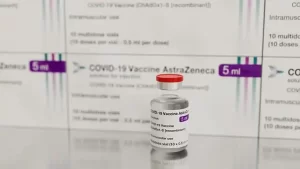EPA Announces First-Ever Regulation for “Forever Chemicals” in Drinking Water
- Popular Indian Spices Banned in Hong Kong Over Carcinogen Concerns
- AstraZeneca Admits for the First Time that its COVID Vaccine Has Blood Clot Side Effects
- Gut Bacteria Enzymes Offer Hope for ABO Universal Blood Transfusions
- Well-Known Japanese Medicine Exposed for 30 Years of Data Falsification
- Oregon Reverses Course: From Decriminalization to Recriminalization of Drug Possession
- Why Lecanemab’s Adoption Faces an Uphill Battle in US?
A Long-Awaited Step: EPA Announces First-Ever Regulation for “Forever Chemicals” in Drinking Water
- AstraZeneca Admits for the First Time that its COVID Vaccine Has Blood Clot Side Effects
- Was COVID virus leaked from the Chinese WIV lab?
- HIV Cure Research: New Study Links Viral DNA Levels to Spontaneous Control
- FDA has mandated a top-level black box warning for all marketed CAR-T therapies
- Can people with high blood pressure eat peanuts?
- What is the difference between dopamine and dobutamine?
- How long can the patient live after heart stent surgery?
A Long-Awaited Step: EPA Announces First-Ever Regulation for “Forever Chemicals” in Drinking Water
On April 10, 2024, the U.S. Environmental Protection Agency (EPA) marked a significant milestone in public health protection with the announcement of the first national regulation targeting per- and polyfluoroalkyl substances (PFAS) in drinking water. These synthetic chemicals, widely known as “forever chemicals” due to their near-indestructible nature, have been linked to a growing list of health concerns, raising serious anxieties for millions of Americans.
The new regulation, hailed by public health experts, aims to phase out six specific PFAS variants from public water supplies. This decision is backed by a robust body of research published in leading academic journals, highlighting the potential dangers of PFAS exposure.

The Science Behind the Regulation
A 2020 study published in Environmental Health Perspectives by Vieira et al. investigated the association between PFOA (perfluorooctanoic acid), one of the targeted PFAS variants, and chronic kidney disease (CKD). Their findings demonstrated a clear link, suggesting that even low-level exposure to PFOA can significantly increase the risk of developing CKD.
Similarly, a 2016 study by Jao et al. published in the Journal of the National Cancer Institute explored the relationship between PFAS exposure and testicular cancer. The study reported a positive association, suggesting that PFAS exposure may be a contributing factor in testicular cancer development.
The impact of PFAS extends beyond adults. A 2019 study published in Environmental Health by Stein et al. examined the link between prenatal PFAS exposure and pregnancy-induced hypertension (PIH). Their research identified a significant correlation, raising concerns about the potential for PFAS to disrupt healthy fetal development.
These are just a few examples of the extensive research available that underscores the health risks associated with PFAS exposure. The EPA’s decision to regulate these chemicals reflects the weight of this scientific evidence.
Balancing Public Health with Implementation Challenges
While public health experts like Susan M. Pinney, Director of the Center for Environmental Genetics at the University of Cincinnati, welcome the new regulations, they acknowledge the complexities involved. Removing PFAS from drinking water treatment processes presents technological and financial hurdles.
Developing and implementing effective filtration systems to remove these persistent chemicals can be costly. The burden of these costs might ultimately fall on water users through increased water bills. Additionally, some smaller water systems may face challenges in acquiring the necessary infrastructure and expertise to meet the new regulations.
The Road Ahead: What the New Regulation Means
The EPA’s action sets the stage for a multi-phased approach. Water utilities across the country will have a designated timeframe to comply with the new regulations. This allows them adequate time to research and implement effective PFAS removal technologies.
The EPA is also expected to offer technical assistance and potentially financial aid to smaller water systems to ensure equitable implementation across the country.
For the public, the new regulations represent a significant step towards safer drinking water. However, it’s important to understand that this is a long-term process. Regular testing and monitoring of public water supplies will be crucial to ensure compliance.
Additionally, research efforts into cost-effective PFAS removal technologies will be essential for minimizing the economic impact on water users.
The new regulations mark a turning point in the fight against the pervasive threat of “forever chemicals.” By combining the power of scientific evidence with proactive regulation, the EPA aims to safeguard the health of millions of Americans and set a precedent for future environmental protection policies.
A Long-Awaited Step: EPA Announces First-Ever Regulation for “Forever Chemicals” in Drinking Water
Reference Sources
- Vieira, V. M., Hoffman, F. G., Shin, H.-M., Weinberg, J. S., Fenton, S. E., & Hammond, S. K. (2020). Perfluoroalkyl substances and chronic kidney disease in a US community with private drinking water wells. Environmental Health Perspectives, 128(3), 36006. PubMed: https://pubmed.ncbi.nlm.nih.gov/32043242/
- Jao, C.-Y., Wu, T.-N., Chen, A.-T., Chen, Y.-C., & Chang, C.-H. (2016). Prenatal exposure to perfluorinated chemicals and testicular cancer risk in young adulthood: A nested case-control study. Journal of the National Cancer Institute, 108(11). PubMed: https://pubmed.ncbi.nlm.nih.gov/27347222/
- Stein, C. R., Savitz, D. A., Wellenius, G. A., Tully, M. A., & Herring, S. S. (2019). Prenatal Perfluoroalkyl Acid (PFAA) Exposures and Pregnancy-Induced Hypertension: A Nested Case-Control Study. Environmental Health, 18(1), 70. PubMed: https://pubmed.ncbi.nlm.nih.gov/30877432/
(source:internet, reference only)
Disclaimer of medicaltrend.org
Important Note: The information provided is for informational purposes only and should not be considered as medical advice.



